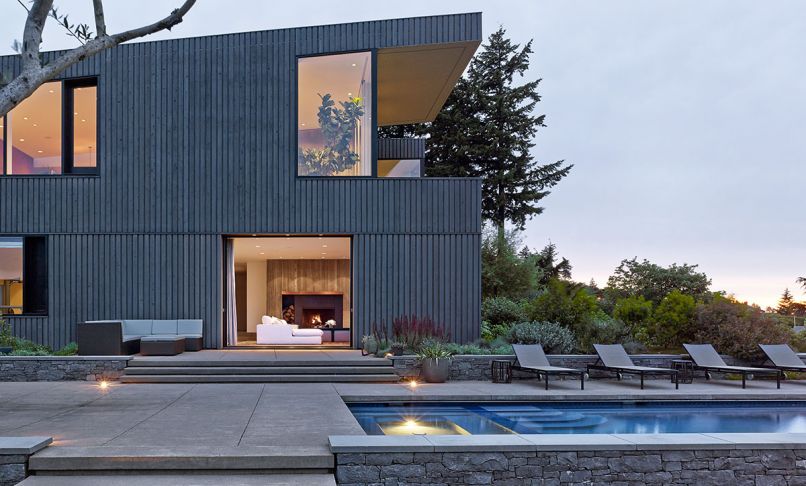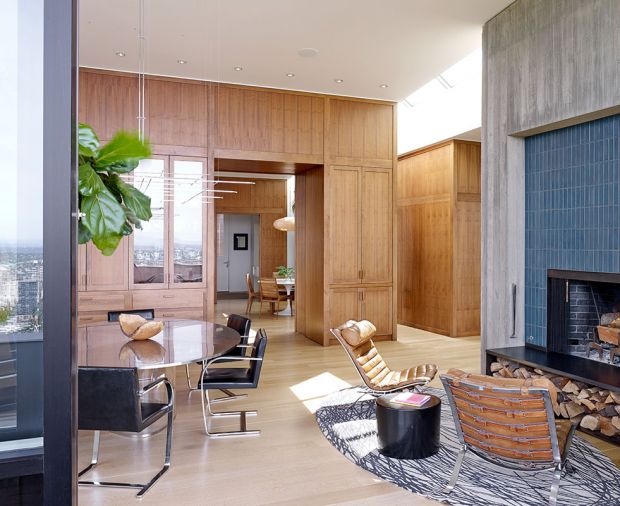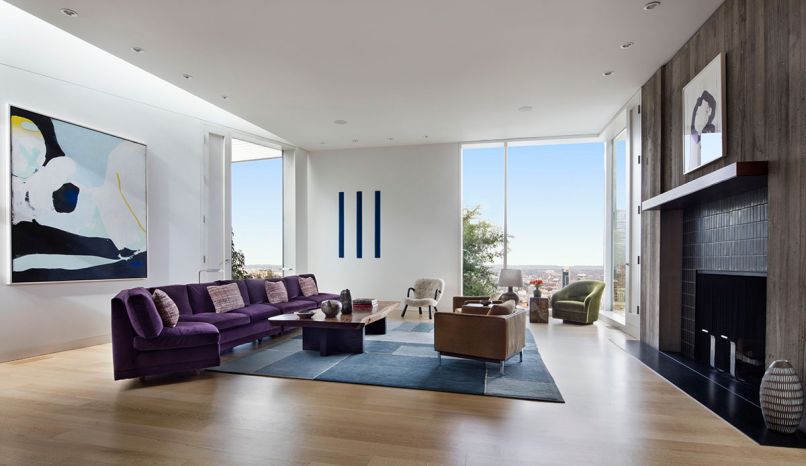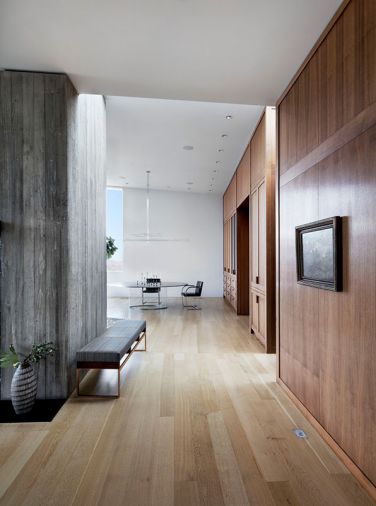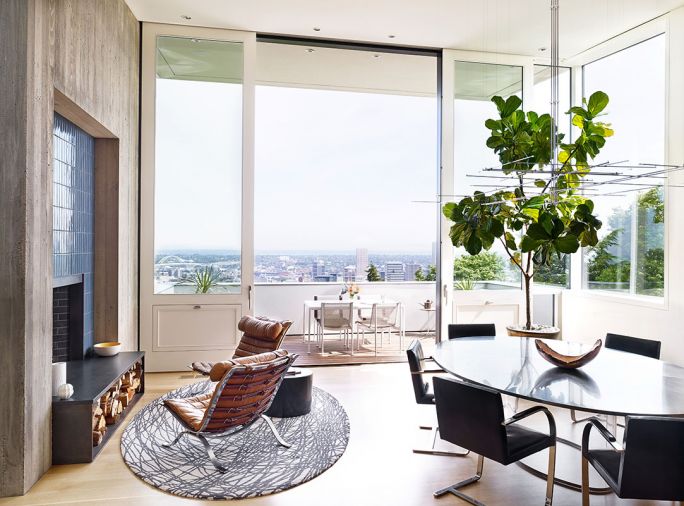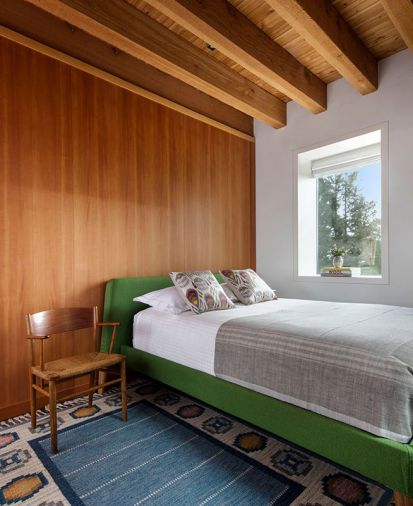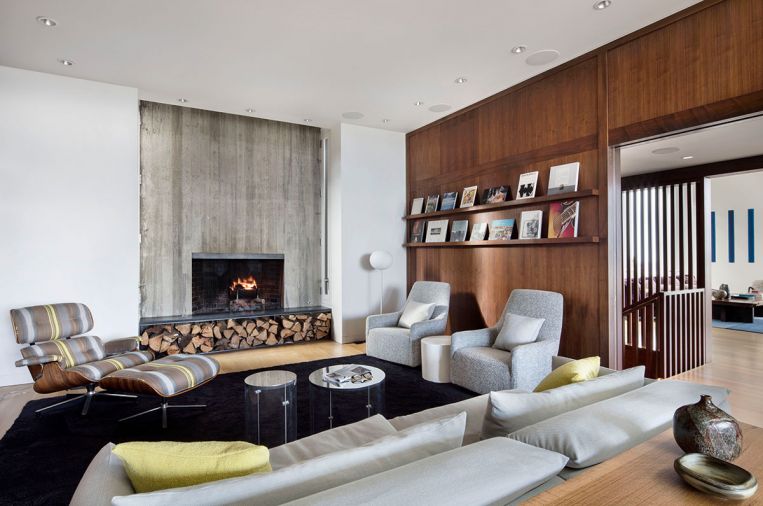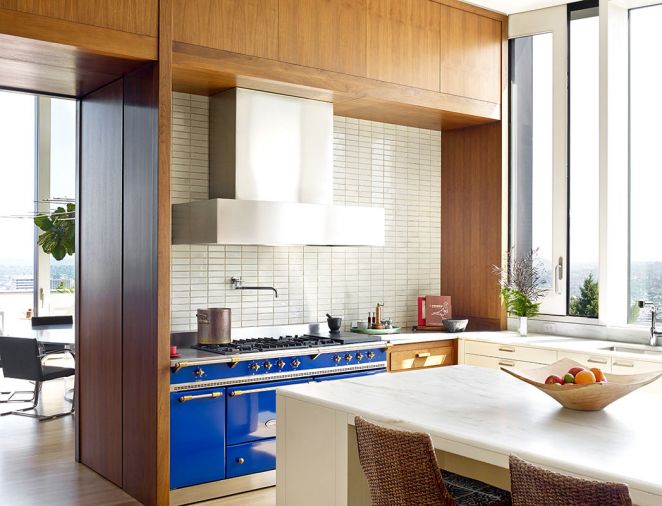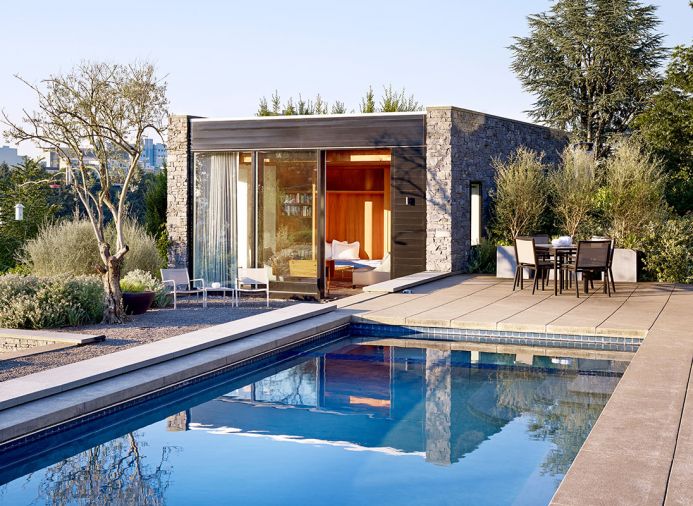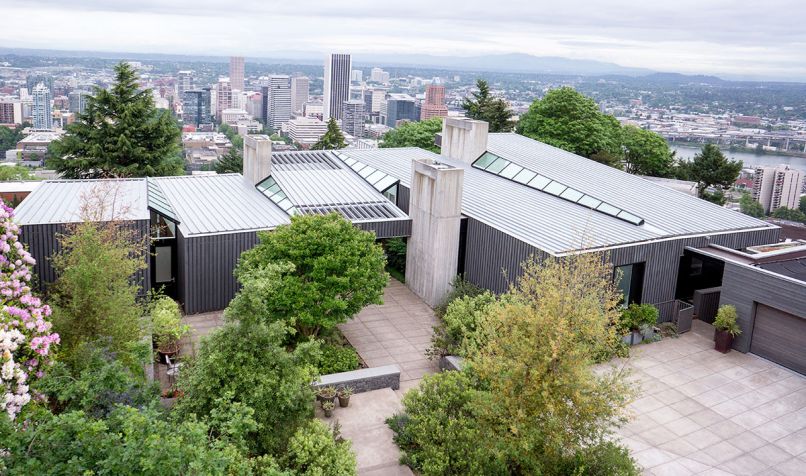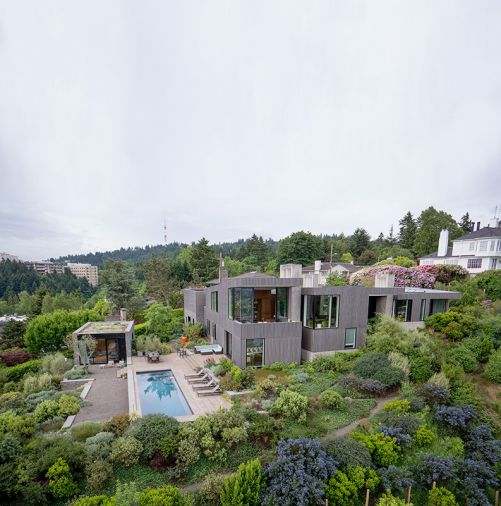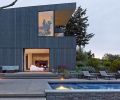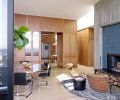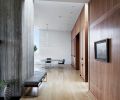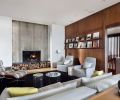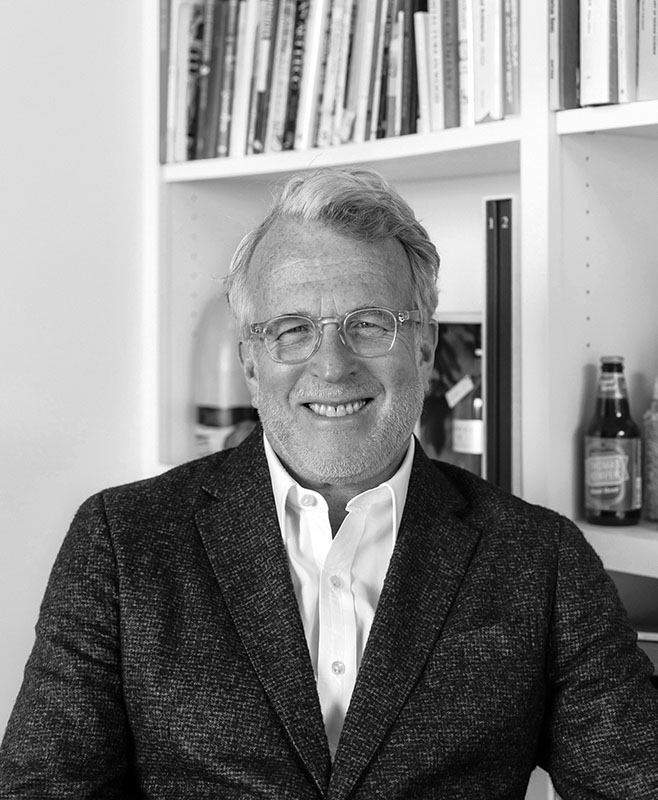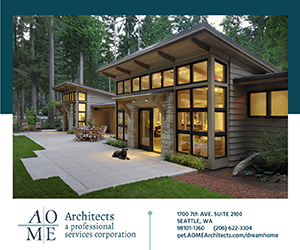A perfect union was formed when a prominent Portland family fortunate enough to live in several historic old homes commissioned Brad Cloepfil of Allied Works Architecture to design their first modern home. Sited on a projected ridge of the Tualatin Mountains, it has epic views of Portland’s iconic mountain ranges, river and downtown.
“The family, which had previously lived in classic and notable historic Portland homes,” says Cloepfil, “had never built a home before. After finding this incredible property, they decided to commission a piece of architecture that would fuel their growing desire to continue living in interesting places.”
As the project began to gear up, Cloepfil called on builder Don Tankersley of Don Tankersley Construction to join the team.“When Brad calls to say, ‘I’ve got a project I want you to look at,’ you come running,” says Tankersley.
“The architecture,” says Cloepfil, “is really about the site, which is true for most of our houses and work. In this case, the permanent markers that hold it to the earth are the three pillars of concrete – the fireplaces, earthworks and terracing. The house itself is more ephemeral, piercing the light through seams in the roof.”
Tankersley agrees. “Those concrete fireplaces have a texture and color that’s very earthen and worn,” he says. “Even though they are big blocks of board formed concrete, they are not cold. They are the found ruins around which the house was built.”
Tankersley loves working with Allied Works’ team, which included Dan Koch on this project, as they will bring him into meetings with the clients, architect and often the designer early in the process, which, he says, creates time and cost saving advantages.
“We had our weekly meetings where the architects would come in with solutions to any problems that the owners would suggest. I’d leave there and go and price it out and try to figure out the details for the architect,” he says.
“Don is a rare builder who completely understands the design intent,” says Cloepfil. “You don’t have to explain very much to him, because he’s very bright and has a good eye, which makes working together a true partnership and a real pleasure.”
“It’s all in the details,” adds Tankersley. “The challenge is to realize the intent of the architect and not let the logistics or the necessities of construction change something the architect wants.”
One such detail is the black walnut cabinetry work, says Tankersley. “Mark Newman Design in Wood painstakingly built all the cabinets in there. He had us all go, the homeowners, Brad, Dan Koch, me and our finisher, Frank McGinnis, on a field trip to a mill, where we picked out each veneer, one by-one. It was a very impressive, fun day!”
Building on the side of a hill was a definite challenge. Concrete work estimated to take three months, took six. “We shaped the whole lot,” says Tankersley, “then did some architectural gymnastics to fit the home to the lot. Cloepfil’s design was all about creating these views. Instead of punching holes in a wall and putting in a window, we removed the wall and replaced it with glass, and completely revealed the view to the edges, so it feels like the end of the pavilion is open, especially in the dining room.”
The dining room became a focal point for New York designer Lisa Frazar of Studio Frazar who was recommended by Cloepfil as a designer who went to architecture school before becoming an interior designer and is simpatico with architects, working in concert with them to enhance their design.
“The house was fully furnished when I was flown out to meet the clients,” recalls Frazar. “I didn’t leave the property for 2 days. During that time, I realized how the ceiling which is splayed open to bring in light made it impossible to introduce rectilinear furnishings like their long dining table, which looked off at all times.”
To address that crucial architectural element of the design, Frazar recommended using an oval Marie Pergay dining table and vintage Mies van der Rohe chairs.“That was our first big purchase and it took us six months to find the table with stainless steel top and lucite base.”
“The clients,” says Cloepfil, “began to question their thinking about furniture and art the more they lived in the house and understood it. They began collecting contemporary art and furniture as they evolved into the house.”
As Cloepfil walked the house with his clients, he discussed ways to make the furnishings inform the architecture. “As the architecture weaves and folds with light, angles and geometry,” he said, “the walnut storage pieces, the presence of the hearth, fireplaces, concrete and tile all ground it.” He cautioned that “Contemporary houses are often more abstract, even if they’re richly, beautifully detailed. Therefore, the role of its furnishings is critical; they must be to the scale of the house. A rote response is a total mistake.”
He also noted that introducing pieces from various moments in history helps give a room a more cohesive feel. “That’s the magic of interior design,” he says. “A lot of contemporary houses looks as if their furnishings were all bought right now, rather than contextualizing things with a bit of history to them. Using furniture from different periods extends the conversation.”
When Frazar came onboard, she worked with the family very closely to carry out the transformation, involving them in the process at every step of the way. “They’re fun, travel all over, shop and collect. This home was a labor of love for them,” she says. “I soon discovered they love color, so as I’d find things, we would replace the existing furniture with colorful pieces like the vintage purple Parzinger sofa, which I bought from a dealer in Sag Harbor.”
“Things took time,” says Frazar, “but each time we introduced a new material, like the metal and lucite Pergay table and the dark leather van der Rohe vintage chairs that complimented the architecture, everyone agreed that the unexpectedness of these furnishings enhanced the home.”
Soon, the couple began adding key elements themselves, such as the large Brooks painting in the living room, which they discovered in a New York art warehouse. “On Valentine’s Day, the husband came to New York looking for a gift for his wife,” recalls Frazar, “and I sent him to my favorite ceramic store in New York City – Freeforms. Now they’ve begun collecting ceramics as well.”
Cloepfil says he doesn’t approach a project with any presumptions. “It’s just a conversation. What’s inspired by the site, particular things a client is interested in, how they live, what phase of life they are in.” Art, he adds, is always a part of that conversation. “This family started collecting art pretty seriously. So, I introduced them to Liz Leach of Elizabeth Leach Gallery in Portland, since she works with a lot of national galleries.”
Well-known for his work on some of America’s notable art museums, Cloepfil used similar design techniques on this home. “We use light in a lot of our projects as shadow play to dematerialize the surface, as we did with the Clyfford Still Museum in Denver,” he says. “By the scaling of pieces of wood so when the sun hits the different façades, different depths, they are made ephemeral by the light.”
Tankersley was particularly taken by this aspect of the design. “You have to see a drawing of it or in person to appreciate what a nice detail it is,” he says. “The board behind the batten is ¾" cedar, while on top, the batten is 5.5" x 1.5" thick with the sides angled back at 10 degrees, which creates a shadow line that looks as if one plane is floating in front of the other.”
Although Tankersley didn’t work with Frazar until his work was done, he was very taken with the way her work complemented the architectural essence of the home.
“I’m just thrilled with the way the furnishings and art really make the house look good,” he says.
“Coming from New York City,” says Frazar, “I’d never been on a project that had such rich landscaping or a house with such amazing materials that captured the light and the views as Brad’s design has done. Frankly, I was a little intimidated at first to put any furniture in the house, but the clients were so enthusiastic and wide-open about collaborating and learning over time that the outcome became so beautiful that we’re still working together on other parts of the house.”
An avid gardener and a member of many of Portland’s gardening clubs, the woman of the house has her own potting shed. She harvests herbs from the garden to make dinner for family and friends alike.
The landscape design was a collaboration between Eric Shriner of Pivot Landscape Architecture and Sean Hogan, the owner of Cistus Nursery, who supplied a lot of the plants and added design assistance. Cloepfil admits he was skeptical at first about the plantings they chose being appropriate for this climate. “I didn’t think it would grow this far north,” he says, “But I was dead wrong! It’s fantastic.” A big gardener himself, Cloepfil loves the minor hiking path the landscape artist created that traverses the topography of the property.
One of the delights of the project, all agree, was the joy of working with the family. “They are true patrons,” says Tankersley. “They made sure we did well, and everyone was having a good time. Working with them and Brad, you really get to work with great materials and craftsmen in town. That’s as good as it can get!”
PROJECT SOURCES
CONTRACTOR
Don Tankersley Construction
www.dtcportland.com
ARCHITECT
Allied Works Architecture
www.alliedworks.com
INTERIOR DESIGN
Studio Frazar
www.studiofrazar.com
ARCHITECTURAL WOODWORKING
Mark Newman Design in Wood
www.marknewman.com
AUDIO VIDEO/HOME THEATER
E Cubed Audio Video LLC
www.E3pdx.com
Swimming Pool: Cascade Pools & Spas; Kitchen Appliances: Liebherr, Lacanche, VentAHood; Bath Plumbing Fixtures: Boffi, Dornbracht, Duravit
Shoptalk
Brad Cloepfil
Brad Cloepfil, Founding Principal Allied Works Architecture
Q: How important is the connection of architecture to other creative art fields?
For me, it’s critical. All one conversation of ideas. I get inspiration from visual art, from the landscape, light, everything. For me, it’s searching for ideas. Ideas are out in the world. So, I look at everything.
Q: How has your style developed and changed over the years?
I don’t have a style. Every project is a new project. My interests change with our office’s ability to build more sophisticated geometry and building tech. My ability to envision things has expanded because our skill set has grown as an office. As a result, we are more speculative in construction. All our work is construction and structure. It has to do with us having to envision and then know how to build what we envision. As a result, we’ve gotten incredibly more sophisticated.
Q: When working on a new project, where do you begin?
The site. Always with the site. What does the site tell us? The City, landscape, project, all exist because of the site and quality of light. Once you understand the potential of the site, then you must ask, “What is the building serving?” The community? Collectors? Students? City? Who is it for? Those are the things that will resonate.
Q: What projects are in your future?
A new School of Art for Pratt Institute. A new winery in Oregon in a Yamhill County landscape. Various other projects, including a sweet building in Corvallis – the Benton County Historical Society in downtown Corvallis. My ultimate quest is to design a spiritual space.
Q: Your work includes major museum projects, cultural institutions and innovative educational facilities. How do you combine functionality and beauty in such complicated environments?
Functionality is never a struggle. The question is, “What are you serving?” Which community? Which city? What kind of space will resonate with that institution? As well as beauty, which, frankly, is very important. It’s an act of respect to make something beautiful for an institution and community. It draws people to come back again and again to enjoy it. People value beauty, not novelty. Novelty is very exciting, but you need to replace it in 3 years. Buildings need a much more enduring presence. Therefore, I serve beauty.
Q: How does the passage of time factor into your work?
Again, the passage of time goes into the same conversation. You attempt to do things that communicate an experience that no one else has had. To create some sort of insight or experience. You want a building to endure, have a sense of timeless, with beautiful proportions, detailing and materiality. To do so, you need to understand the nature of rooms that last, that people want to use again and again. Although the functions of rooms may change, buildings remain. Rooms of value that sustain their purpose and validity are those that can embrace the function of change around and within them. Those are the rooms you want to make – that can be used 200 years later, yet still have the same resonance that people value.
Q: When you’re not working, what do you enjoy?
Gardening. Cooking and baking breads. Because my life is so public, and I travel so much, I tend to burrow in and be domestic at home. A favorite book is “The Complete Book of Breads” by Bernard Clayton.
Q: Figures that have inspired your work over the years?
It’s ongoing. Artists as much as anyone else: Richard Serra, sculptor, Eva Hesse. Obviously, Peter Zumthor, who is very inspiring.

